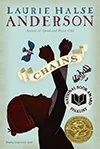◼︎ Chapter 2 / Chapter II
What is the narrator’s name, and the names of her sister?
The narrator and her sister are “free”: “Ms. Finch freed us in her will.”
What might that mean?
Mr. Robert says, “These girls should bring a decent price at auction.”
What is an auction?
What is Mr. Robert talking about?
Hint: Look at illustrations below.
Describe Mr. Robert’s character as best you can.
Write about 3 things you have learned about slavery in this chapter.
Pastor Weeks carries a Bible and owns a slave.
What do you think about that?
BONUS: Write a question for this chapter.
Answer your own question.
• Mother and child at auction.
Although today we see slavery in moral terms, during the early years of the slave trade up until the Civil War, most Americans saw slaves as property, like a car or a computer.
Owning slaves was an inalienable right for those who had the money to afford them.
During the eighteenth century, slavery itself became inextricably bound up with consumerism.
By mid-century, a third of the British merchant fleet was engaged in transporting 50,000 Africans a year to the New World.
American ship owners, farmers, and fisherman also profited from slavery. Proponents of slavery needed to look no further than the Bible to justify "the peculiar institution."
A common argument for slavery was found in the book of Genesis, chapter 9, in which Noah's youngest son Ham saw the nakedness of his father and had his brothers cover him.
Noah then cursed Ham to be a servant to his brothers forever: "Cursed be Canaan! The lowest of slaves will he be to his brothers" (Genesis 9:25-26).
Many interpreted Ham's curse as placed upon people of darker skin color - specifically, Africans.
The argument's circular logic stated that since Ham's descendants were to be slaves forever, and Africans were already slaves and inferior, then they should remain in slavery.
Source: https://www.pbs.org/thisfarbyfaith/journey_1/p_6.html



